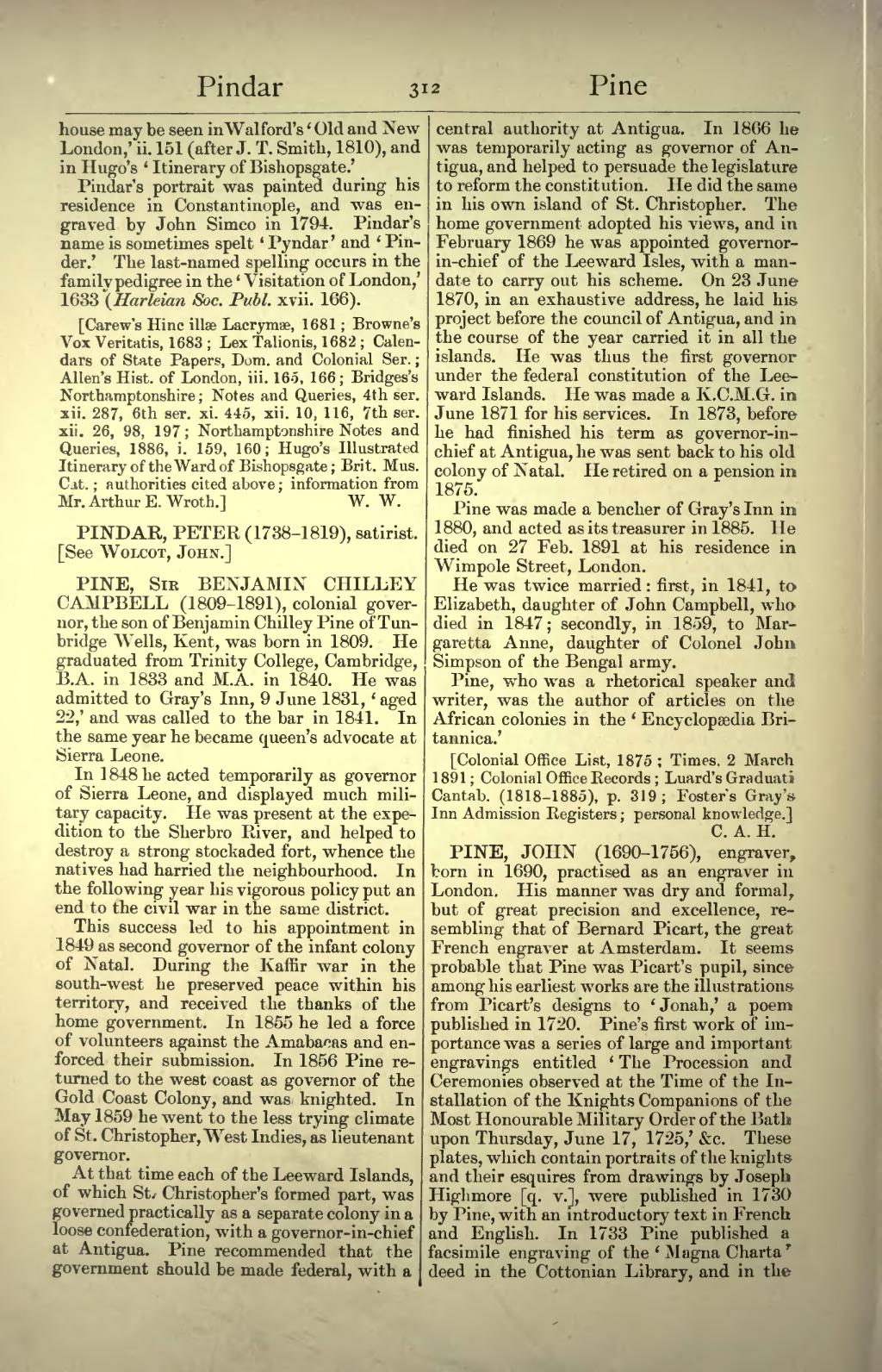house may be seen in Walford's ‘Old and New London,’ ii. 151 (after J. T. Smith, 1810), and in Hugo's ‘Itinerary of Bishopsgate.’
Pindar's portrait was painted during his residence in Constantinople, and was engraved by John Simco in 1794. Pindar's name is sometimes spelt ‘Pyndar’ and ‘Pinder.’ The last-named spelling occurs in the family pedigree in the ‘Visitation of London,’ 1633 (Harleian Soc. Publ. xvii. 166).
[Carew's Hinc illæ Lacrymæ, 1681; Browne's Vox Veritatis, 1683; Lex Talionis, 1682; Calendars of State Papers, Dom. and Colonial Ser.; Allen's Hist. of London, iii. 165, 166; Bridges's Northamptonshire; Notes and Queries, 4th ser. xii. 287, 6th ser. xi. 445, xii. 10, 116, 7th ser. xii. 26, 98, 197; Northamptonshire Notes and Queries, 1886, i. 159, 160; Hugo's Illustrated Itinerary of the Ward of Bishopsgate; Brit. Mus. Cat.; authorities cited above; information from Mr. Arthur E. Wroth.]
PINDAR, PETER (1738-1819), satirist. [See Wolcot, John.]
PINE, Sir BENJAMIN CHILLEY CAMPBELL (1809–1891), colonial governor, the son of Benjamin Chilley Pine of Tunbridge Wells, Kent, was born in 1809. He graduated from Trinity College, Cambridge, B.A. in 1833 and M.A. in 1840. He was admitted to Gray's Inn, 9 June 1831, ‘aged 22,’ and was called to the bar in 1841. In the same year he became queen's advocate at Sierra Leone.
In 1848 he acted temporarily as governor of Sierra Leone, and displayed much military capacity. He was present at the expedition to the Sherbro River, and helped to destroy a strong stockaded fort, whence the natives had harried the neighbourhood. In the following year his vigorous policy put an end to the civil war in the same district.
This success led to his appointment in 1849 as second governor of the infant colony of Natal. During the Kaffir war in the south-west he preserved peace within his territory, and received the thanks of the home government. In 1855 he led a force of volunteers against the Amabacas and enforced their submission. In 1856 Pine returned to the west coast as governor of the Gold Coast Colony, and was knighted. In May 1859 he went to the less trying climate of St. Christopher, West Indies, as lieutenant governor.
At that time each of the Leeward Islands, of which St. Christopher's formed part, was governed practically as a separate colony in a loose confederation, with a governor-in-chief at Antigua. Pine recommended that the government should be made federal, with a central authority at Antigua. In 1866 he was temporarily acting as governor of Antigua, and helped to persuade the legislature to reform the constitution. He did the same in his own island of St. Christopher. The home government adopted his views, and in February 1869 he was appointed governor-in-chief of the Leeward Isles, with a mandate to carry out his scheme. On 23 June 1870, in an exhaustive address, he laid his project before the council of Antigua, and in the course of the year carried it in all the islands. He was thus the first governor under the federal constitution of the Leeward Islands. He was made a K.C.M.G. in June 1871 for his services. In 1873, before he had finished his term as governor-in-chief at Antigua, he was sent back to his old colony of Natal. He retired on a pension in 1875.
Pine was made a bencher of Gray's Inn in 1880, and acted as its treasurer in 1885. He died on 27 Feb. 1891 at his residence in Wimpole Street, London.
He was twice married: first, in 1841, to Elizabeth, daughter of John Campbell, who died in 1847; secondly, in 1859, to Margaretta Anne, daughter of Colonel John Simpson of the Bengal army.
Pine, who was a rhetorical speaker and writer, was the author of articles on the African colonies in the ‘Encyclopædia Britannica.’
[Colonial Office List, 1875; Times, 2 March 1891; Colonial Office Records; Luard's Graduati Cantab. (1818–1885), p. 319; Foster's Gray's Inn Admission Registers; personal knowledge.]
PINE, JOHN (1690–1756), engraver, born in 1690, practised as an engraver in London. His manner was dry and formal, but of great precision and excellence, resembling that of Bernard Picart, the great French engraver at Amsterdam. It seems probable that Pine was Picart's pupil, since among his earliest works are the illustrations from Picart's designs to ‘Jonah,’ a poem published in 1720. Pine's first work of importance was a series of large and important engravings entitled ‘The Procession and Ceremonies observed at the Time of the Installation of the Knights Companions of the Most Honourable Military Order of the Bath upon Thursday, June 17, 1725,’ &c. These plates, which contain portraits of the knights and their esquires from drawings by Joseph Highmore [q. v.], were published in 1730 by Pine, with an introductory text in French and English. In 1733 Pine published a facsimile engraving of the ‘Magna Charta’ deed in the Cottonian Library, and in the
